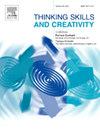The integration of technology and education: An innovative research on the evaluation system of college students’ programming ability
IF 4.5
2区 教育学
Q1 Social Sciences
引用次数: 0
Abstract
The rapid development of artificial intelligence technology has made programming ability a core competency for college students. However, the existing single-indicator evaluation system struggles to accurately distinguish between different levels of ability, highlighting the urgent need for a scientific and multidimensional evaluation system. In this study, the AHP-TOPSIS method was adopted. Combined with the grades of programming-related courses and competition results, a multi-dimensional evaluation system for programming design ability was constructed, and a comprehensive score was given to 307 students. The results show that the weight of mathematical analysis ability is the highest (0.26), highlighting its core position in programming education. Furthermore, the comprehensive scores of students follow a normal distribution. 68 % of the students' scores are concentrated between 70 and 79 points, which can effectively distinguish students of different ability levels. Further analysis indicates that there is a strong positive correlation between course grades and competition grades (Pearson's r = 0.78), emphasizing the importance of a solid course foundation for the development of programming ability. Furthermore, there was no significant difference in the comprehensive score between genders (p = 0.22, Cohen's d = -0.15), indicating that programming education should focus on individual differences rather than gender. The evaluation system proposed in this paper not only provides scientific assessment tools for educational institutions, but also offers a basis for optimizing teaching strategies, improving teaching quality and the quality of talent cultivation, which is of great significance to the reform and innovation of computer education.
科技与教育的融合:大学生编程能力评价体系的创新研究
人工智能技术的快速发展使编程能力成为大学生的核心竞争力。然而,现有的单指标评价体系难以准确区分不同的能力水平,迫切需要一个科学的、多维的评价体系。本研究采用AHP-TOPSIS方法。结合编程相关课程成绩和竞赛结果,构建了一个多维度的编程设计能力评价体系,对307名学生进行了综合评分。结果表明,数学分析能力的权重最高(0.26),突出了其在编程教育中的核心地位。学生的综合成绩服从正态分布。68%的学生成绩集中在70 - 79分之间,可以有效区分不同能力水平的学生。进一步分析表明,课程成绩与竞赛成绩之间存在很强的正相关关系(Pearson’s r = 0.78),强调了扎实的课程基础对于编程能力发展的重要性。此外,综合得分在性别之间没有显著差异(p = 0.22, Cohen’s d = -0.15),说明编程教育应该关注个体差异而不是性别差异。本文提出的评价体系不仅为教育机构提供了科学的评价工具,而且为优化教学策略、提高教学质量和人才培养质量提供了依据,对计算机教育的改革创新具有重要意义。
本文章由计算机程序翻译,如有差异,请以英文原文为准。
求助全文
约1分钟内获得全文
求助全文
来源期刊

Thinking Skills and Creativity
EDUCATION & EDUCATIONAL RESEARCH-
CiteScore
6.40
自引率
16.20%
发文量
172
审稿时长
76 days
期刊介绍:
Thinking Skills and Creativity is a new journal providing a peer-reviewed forum for communication and debate for the community of researchers interested in teaching for thinking and creativity. Papers may represent a variety of theoretical perspectives and methodological approaches and may relate to any age level in a diversity of settings: formal and informal, education and work-based.
 求助内容:
求助内容: 应助结果提醒方式:
应助结果提醒方式:


